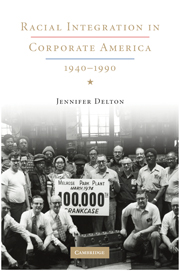Book contents
- Frontmatter
- Contents
- List of Tables
- Introduction
- PART I COLOR-BLIND GROUNDWORK, 1940–1961
- PART II COLOR-CONSCIOUS ASCENDANCY, 1961–1990
- 6 How Compliance Became Voluntarism
- 7 The National Association of Manufacturers Helps Out
- 8 Changing Hiring Criteria
- 9 The Du Pont Company's Affirmative Action Efforts
- Epilogue: From Affirmative Action to Diversity
- Statistical Tables
- Bibliography
- Acknowledgments
- Index
- References
6 - How Compliance Became Voluntarism
Published online by Cambridge University Press: 05 June 2012
- Frontmatter
- Contents
- List of Tables
- Introduction
- PART I COLOR-BLIND GROUNDWORK, 1940–1961
- PART II COLOR-CONSCIOUS ASCENDANCY, 1961–1990
- 6 How Compliance Became Voluntarism
- 7 The National Association of Manufacturers Helps Out
- 8 Changing Hiring Criteria
- 9 The Du Pont Company's Affirmative Action Efforts
- Epilogue: From Affirmative Action to Diversity
- Statistical Tables
- Bibliography
- Acknowledgments
- Index
- References
Summary
Our experience in the recent hearings on equal pay for equal work legislation has convinced us that the only way to approach issues of this kind is to improve management performance to the point where it can be defended on the basis of factual accomplishment.
National Association of Manufacturers memo, 1948There is something about the threat of prosecution that seems to make voluntary programs work much better.
Ray Marshall, 1965As pressure from civil rights groups and the federal government increased in the late 1950s and early 1960s, executives at the largest corporations began integrating their firms. But they insisted that their actions were voluntary. “Our action was not dictated by government pressure or by a desire to be well-regarded, but simply as recognition of an obligation to do what is right,” said General Electric president Frank L. Borch about GE's nondiscrimination policy. Civil rights activists and their allies, as well as historians, mocked the business community's pretensions of voluntarism. To do what laws required one to do anyway could hardly be regarded as voluntary. There was, however, an element of truth in businessmen's claim of voluntarism.
The various state agencies charged with enforcing state antidiscrimination laws were notoriously weak and uncertain of their authority. Constitutional concerns constrained the presidential contract compliance committees. In addition, both the state agencies and the compliance committees had difficulty defining or even identifying discrimination.
- Type
- Chapter
- Information
- Racial Integration in Corporate America, 1940–1990 , pp. 163 - 193Publisher: Cambridge University PressPrint publication year: 2009



